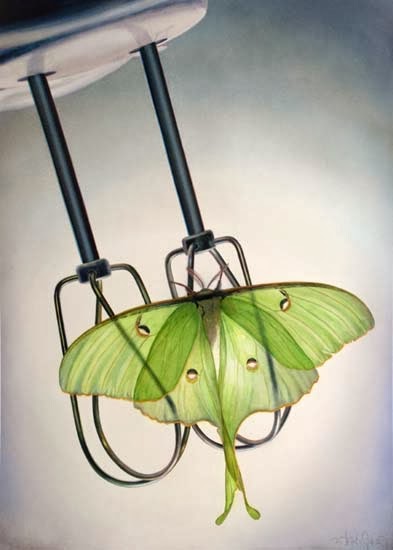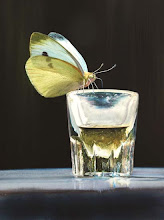 |  |
| Betzi Stein, "Massage series," wax crayon and colored pencil on duralar | Teri Starkweather, "Sunflowers & Coffee," watercolor on paper |
One of the subjects we discussed over our crisp iceberg salads was "why watercolor?" I skipped over my usual transparency/fragility spiel and offered up a basic practical concern of mine, which is that I work in a tiny, poorly ventilated space and so I switched from oils to watercolor six years ago in order to stop poisoning myself with alkyd fumes and other toxins. That's not the only reason, of course, but one question that came up in that context was whether I had tried water-based oils, followed by some enthusiastic recommendations from my fellow luncheoneers in favor of that peculiar medium. I confessed I had not explored this possibility, and I've actually been scratching my head over the concept for a few years since these products first started appearing in art stores -- I mean, mixing water and oil... How does that work? And who is using these paints? And why do they seem to come in so few colors? I resolved to look into it.
The basic idea is that the oil in these water-mixable paints has been modified ("soapanified," as an artist friend of mine likes to say) in order to prevent it from repelling water, as normal oils are inclined to do. The theory is that this allows you to paint with oils without needing turpentine or mineral spirits. Brushes can be cleaned with water, in theory, and there are less toxic, water-based painting mediums. Sounds ideal, right? So who is using these paints? They seem to be popular with art students, particularly since many art departments are apparently now prohibiting paints requiring solvents (i.e., traditional oil paints) in classrooms and shared studios where everyone breathes the same air. Most of the manufacturers, for example Winsor & Newton, claim their water-based oils contain the same pigment load as their top of the line artist paints, so these are not considered "student-grade" paints (such as W & N's Cotman line). So I decided to take the water-based plunge, that is, to try these Winsor & Newton water-based oils, to see how they compare to their traditional oils, by using them to complete a small test painting.
With what results? Well, in a nutshell, and despite the odor-free experience, they stink, figuratively speaking. Sorry for my lack of nuance. A more delicate way to put this might be to say they seem to be a very different medium than traditional oils, with a very different feel and drying characteristics. I expect they could possibly carry you to lofty heights once you've mastered their various peculiarities, but is it worth the trouble to re-adjust one's entire process and technique to accommodate a new medium with its own strange quirks and pitfalls, and which promises nothing more than to be an adequate substitute for something that already works? For me the answer was nay.
To start with, I found the feel of the water-based oil paints under the brush to be decidedly different than traditional oils. They had a chalky, pasty feel rather than the buttery slipperiness one expects with oil paint. If I closed my eyes it was easy to imagine I was painting with huge lumps of goauche. The paint also seemed to have a little too much affinity for the brush, which seemed to increase over time. It needed to be coaxed onto the canvas, especially after a few minutes had elapsed. I'll come back to that alarming tendency in a moment. I tried mixing color with both the Winsor & Newton water-based oil painting medium and the W & N water-based fast-drying medium (but not both at the same time). There is also a W & N water-mixable oil thinner All these products are sold only in tiny 75 mL bottles, as far as I've been able to determine -- not very economical for a serious artist working large.
Does the paint really clean up with just water? Well, sort of. True, most of the paint will come off the brush if you swish it around in a cup of water, but to get a brush completely paint free turns out to require soap and water in the kitchen, or a standard oil-based clearning routine involving turps or mineral spirits (the use of which with these paints leads one to wonder what's the point...?). In short, water alone does not seem to do the job adequately.
But now to the worst part... There is a strange transformation in the paint-handling characteristics that seems to happen early in the drying process, within just a few mintues. For better or worse, I am a compulsive blender of oil paints, and I'm constantly working and reworking wet areas, both smoothing brushstrokes and introducing and blending new color. Well, these habits quite frequently induced disastrous results with water-based oils. Within a few minutes of putting down a new paint layer (and I believe the length of the safe interval corresponds to the amount of time it takes for the water in that new paint film to evaporate), the introduction of any new moisture, for example by means of a new paint load on a still-wet brush, seems to cause the still-wet (but now waterless) paint layer on the canvas to detach from the canvas and stick to the brush in nasty clumpy globs. If you have just spent five minutes delicately blending a smooth color transition, you are not going to be happy when your beautiful paint film suddenly rolls off the canvas into ugly clumps just because you have decided to continue working on it. There may be a workaround, such as using only a completely dry brush and ensuring the new paint introduced to a drying area contains zero water before continuing to re-work a partially dried passage, but as far as I am concerned, this is a major risk factor.

I abandoned the above test painting due to clumping of water-mixable oil paint as it became hyper-hydrosensitive when I spent more than a few minutes blending the wet paint.

This is a similar test painting completed using traditional oils, which allowed unlimited reworking of the wet paint with no danger of sudden changes in handling characteristics. Notice the smoother texture of the background. I think I'll stick with what works!
To be fair, I have only tried Winsor & Newton water-mixable oils and mediums. Paints/mediums from other manufacturers may behave differently. But my experience has convinced me that these paints are really intended for hobbyists and students, not for serious artists. The limited color selection and the availability of the water-based painting mediums and thinners only in small sizes further supports this view. And the risk of having a smooth paint film suddenly become a clumpy mess is the deal-killer. I would use these paints only if I had absolutely no choice. Otherwise, well, it was an interesting experiment, but one that I see no reason to repeat.
Instead, I have addressed the ventilation issue in my studio more forcefully, by cutting open a new window on an ocean-facing wall, with new fans for both sides to ensure a strong airflow from west to east. And I have returned to painting with traditional oil paints, with traditional solvents, and with my favorite fast-drying alkyd medium, the lovely Liquin. And if all this is still shortening my life expectancy, despite the improved ventilation, well... at least I'll get some smooth blending done in the time available. New images of completed oil paintiings are hopefully coming soon...

My new studio window... I can breathe again!

